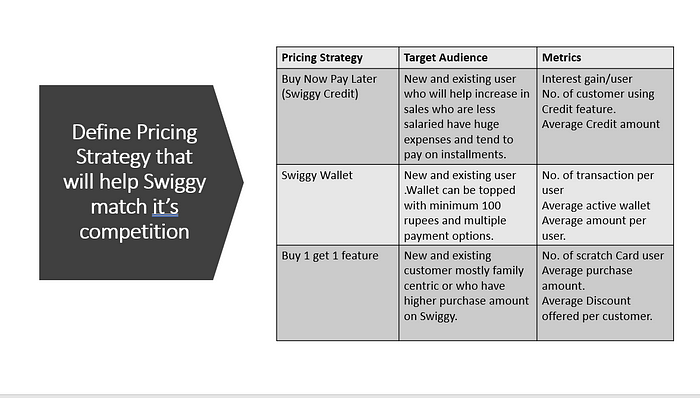Pricing Strategy of Swiggy

Note: This is a case study I submitted during my academic phase in a cohort based Product management course. The view and research in this case may or may not represent reality . The intention is to understand and learn about how pricing strategy works for food delivery services like Swiggy.
Introduction
Swiggy is a food delivery company founded by Nandan Reddy ,Sriharsha majesty,Rahul Jamini. Back in 2014, the concept of online food ordering was pretty much negligible and this called for demand in the market.Swiggy was started in a small office space in Koramangala, Bangalore and the company started off with limitations. The initial setup of food delivery was targeted at a single neighbourhood with 25 partner restaurants and six delivery executive personnel.
Swiggy earns its revenue from two major channels:Commission that are collected from restaurants in return for leads generated through swiggy for being a delivery partner.Delivery fee charged to customer if their order value is below certain threshold.(Below picture shows their income sources for FY20)

Swiggy had Zomato as its main competition however with the expansion of Uber Eats using Uber Drivers and Zomato adjusting it’s pricing strategy using Zomato gold Swiggy has to come up with unique pricing strategy.
Who are Swiggy’s Stakeholders?

Stakeholder definition is the people with an interest or concern in something, especially a business. Swiggy’s stakeholders are its customers to whom service matters , quality of restaurant matters,hygiene matters. Employees who through their innovative ideas can help in business growth as well as brand value to the company. With more participation of Delivery Partner food can be served quickly to the customer. Restaurants through their listing can generate profit and good name amongst people.
But our next question is how Pricing has been perceived by each of these stakeholders.

After we have discussed the stakeholder’s pricing strategy let’s suggest some of the Pricing strategy that can come into play.
Penetration Pricing: During Initial days to attract customer and gain market share Prices were curtailed.
Demand based Pricing: •With the increase in Demand and when Swiggy start getting recognition Surge Pricing,Higher demand drives price higher got implemented.
Value based Pricing : As company is on growth phase more value/service is provided for the higher prices than the competitors.Special offers by Swiggy partnered Restaurants like ‘Burger King at 129’, Buy 1 Get 1 Free and other offers based on demand and location.
Our focus on this case study was how can we define the pricing strategy for Swiggy so that it can come at par with their competitors. Since Zomato is the leading market share and they are doing user acquisition by collaborating with influencers and provide Promo code for certain time or collaborating with restaurants to give good deals. We have also suggested some of the pricing strategy that can benefit Swiggy to be at par with competitors.

Our next question would be the pricing strategy that we proposed how will it benefit Swiggy.
- Sustain Business and focus on acquiring new customers through campaigns,Influencers and celebrities making Swiggy Popular with catchy notifications ‘I saw you checking out on Chinese.’
- Maintain Profitability in this cut throat competitive market
- Proposed Pricing and increase market share to be at par with their competitors.
This was great learning experience from our cohort case study about complex topic like Pricing Strategy. I would like to thank my mentor Prasaanth Tavalam and Talvinder For providing such a case study and guide us through this journey.
